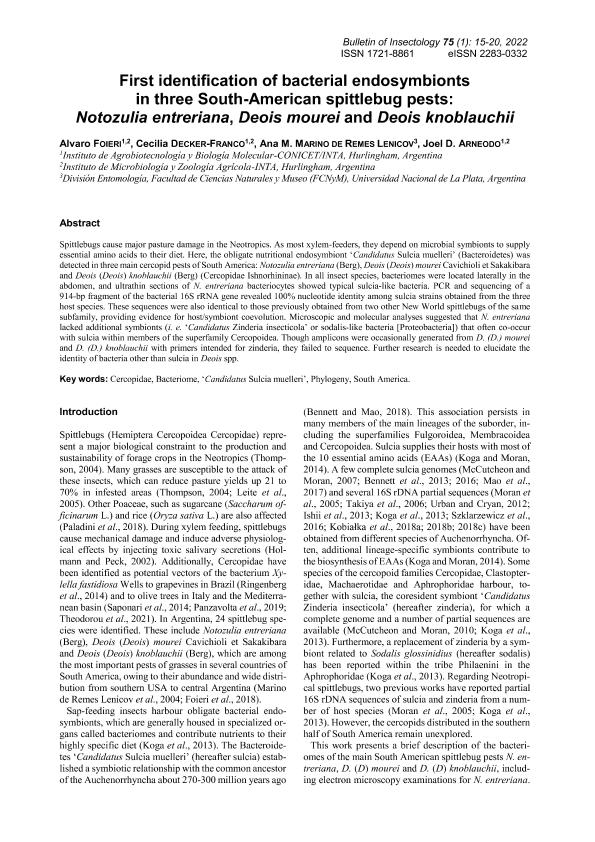Artículo
First identification of bacterial endosymbionts in three South-American spittlebug pests: Notozulia entreriana, Deois mourei and Deois knoblauchii
Foieri, Alvaro ; Decker Franco, Cecilia
; Decker Franco, Cecilia ; Marino de Remes Lenicov, Ana M.; Arneodo Larochette, Joel Demián
; Marino de Remes Lenicov, Ana M.; Arneodo Larochette, Joel Demián
 ; Decker Franco, Cecilia
; Decker Franco, Cecilia ; Marino de Remes Lenicov, Ana M.; Arneodo Larochette, Joel Demián
; Marino de Remes Lenicov, Ana M.; Arneodo Larochette, Joel Demián
Fecha de publicación:
10/2021
Editorial:
Alma Mater Studiorum, Univ Bologna
Revista:
Bulletin Of Insectology
ISSN:
1721-8861
Idioma:
Inglés
Tipo de recurso:
Artículo publicado
Clasificación temática:
Resumen
Spittlebugs cause major pasture damage in the Neotropics. As most xylem-feeders, they depend on microbial symbionts to supply essential amino acids to their diet. Here, the obligate nutritional endosymbiont ‘Candidatus Sulcia muelleri’ (Bacteroidetes) was detected in three main cercopid pests of South America: Notozulia entreriana (Berg), Deois (Deois) mourei Cavichioli et Sakakibara and Deois (Deois) knoblauchii (Berg) (Cercopidae Ishnorhininae). In all insect species, bacteriomes were located laterally in the abdomen, and ultrathin sections of N. entreriana bacteriocytes showed typical sulcia-like bacteria. PCR and sequencing of a 914-bp fragment of the bacterial 16S rRNA gene revealed 100% nucleotide identity among sulcia strains obtained from the three host species. These sequences were also identical to those previously obtained from two other New World spittlebugs of the same subfamily, providing evidence for host/symbiont coevolution. Microscopic and molecular analyses suggested that N. entreriana lacked additional symbionts (i. e. ‘Candidatus Zinderia insecticola’ or sodalis-like bacteria [Proteobacteria]) that often co-occur with sulcia within members of the superfamily Cercopoidea. Though amplicons were occasionally generated from D. (D.) mourei and D. (D.) knoblauchii with primers intended for zinderia, they failed to sequence. Further research is needed to elucidate the identity of bacteria other than sulcia in Deois spp.
Palabras clave:
CERCOPIDAE
,
BACTERIOME
,
CANDIDATUS SULCIA MUELLERI
,
PHYLOGENY
Archivos asociados
Licencia
Identificadores
Colecciones
Articulos (IABIMO)
Articulos de INSTITUTO DE AGROBIOTECNOLOGIA Y BIOLOGIA MOLECULAR
Articulos de INSTITUTO DE AGROBIOTECNOLOGIA Y BIOLOGIA MOLECULAR
Citación
Foieri, Alvaro; Decker Franco, Cecilia; Marino de Remes Lenicov, Ana M.; Arneodo Larochette, Joel Demián; First identification of bacterial endosymbionts in three South-American spittlebug pests: Notozulia entreriana, Deois mourei and Deois knoblauchii; Alma Mater Studiorum, Univ Bologna; Bulletin Of Insectology; 75; 1; 10-2021; 15-20
Compartir



